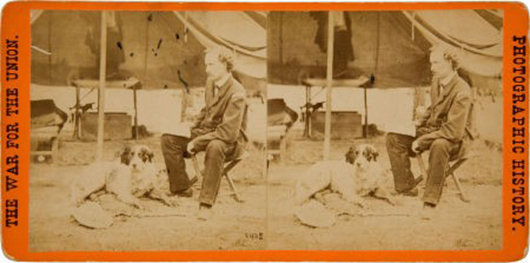
So it was earlier this month as some 75 self-described geeks from 16 states visited to focus on images, from the famous to the virtually unknown, recorded on fragile glass plates during the Civil War.
Their guided walks at historic sites in the city and Spotsylvania, Orange and Hanover counties were but one part of the Center for Civil War Photography’s 2014 “Image of War” seminar, co-sponsored by the Civil War Trust.
Wartime photographers recorded many of their images in stereo, hence the visitors’ 3-D spectacles. Printed on mass-produced cards and seen through a handheld viewer, the stereo views are sharp and vivid – and were a wildly popular 19th-century medium.
Such photos may be old, but the recent visitors were seeing them in fresh ways, at the very spots where they were created, with helpful context and insight provided by on-site experts and historians.
Time and again over three days, people young and old exclaimed with a “wow” or a collective “ooh” at some new discovery, scene or realization.
Those reactions didn’t surprise Garry Adelman, the center’s vice president. Better than most, he understands the powerful sense of immediacy that the photos give people, even 150-plus years later.
“Paintings or drawings don’t strike people the same way,” Adelman said in an interview. “Civil War photographs are among the oldest news photos, and among the oldest images of real people and real buildings and real landscapes, that one can see.”
The war was the first time that people were taking cameras and regularly recording news of national import as it happened, he said.
“These images provided the public with an overwhelming reality about scenes in the field,” Adelman said. “Documentary photography was born during the Civil War.”
One such scene that received special attention during the war, and recently, was the Marye family house in Fredericksburg. When Union forces stormed Marye’s Heights on May 3, 1863, after Maj. Gen. Ambrose Burnside’s humiliating defeat there the previous December, the place drew photographers like a magnet.
Seminar attendees flocked there Oct. 11 to walk the same ground, seek out the wartime photographers’ camera positions and make their own then-and-now comparisons.
Atop the heights, they trod Willis Hill, Fredericksburg National Cemetery and the grounds around the mansion of John L. Marye Sr., the area’s delegate to the Virginia secession convention in 1861. Today, it’s known as Brompton, home of University of Mary Washington President Richard Hurley.
Many well-known photos of Brompton and its surroundings were recorded by Andrew J. Russell; James Gardner, brother of Washington-based photographer Alexander Gardner; and photographers with Mathew Brady & Co. Among the most widely published images is one of wounded Indian soldiers, sharpshooters with the 2nd Minnesota Regiment, lying in the shade beneath an oak tree. That “witness” tree still stands beside Brompton, and is carefully tended by UMW groundskeepers.
Amid a light drizzle, CCWP members moved across the grounds to eye big enlargements of 3-D photos staked into the ground at the precise locations where the photographers stood. People could view those historic scenes, then look beyond them into the present, creating “4-D” moments in which time is the fourth dimension.
“They are like windows in time,” Adelman said of the 3-D anaglyphs. “Looking into them is magic.”
Attendees also posed in front of Brompton for a group portrait by Rob Gibson, a wet-plate photographer with a popular studio in Gettysburg, Pa., then rushed to his developing apparatus to watch him process the glass plate in a chemical bath.
Moving down to the Sunken Road, they paused where Russell, a Union army photographer, planted his tripod to record one of the war’s most famous images – of Confederate dead lying beside the road’s stone wall just minutes after U.S. troops breached those defenses and seized the ground.
“By any account, that is the most immediate photo taken during the war after a successful attack,” said Adelman, who is also the Civil War Trust’s director of history and education.
Inside the Fredericksburg Battlefield Visitor Center, attendees viewed a 3-D video of historic photos, created by CCWP imaging director John Richter, that just opened there.
The center’s members covered a lot of ground in their time here. Moving with dispatch that Confederate commander Thomas J. “Stonewall” Jackson would have envied, the group visited the Fredericksburg, Chancellorsville, Wilderness, Spotsylvania Court House and North Anna battlefields in two days.
Collectively, the members – who delight in analyzing the smallest detail in Civil War photos to see what can be learned – have made many finds.
Local examples include determining that a famous in-the-trenches image of Union soldiers was taken near the Rappahannock River in Spotsylvania, not Petersburg, as had long been thought. They also identified the only known Confederate in a Russell image of Fredericksburg taken from Stafford; properly credited Russell with the Sunken Road photo, which some had attributed to Mathew Brady’s studio; and deduced where in Fredericksburg an evocative series of images of a Union burial party was taken after the Battle of the Wilderness.
The center also works with the Library of Congress to preserve and digitize wartime photographs.
___
Online:
CCWP: www.civilwarphotography.org
3D images: www.civilwar.org/photos/3d-photography-special
___
Information from: The Free Lance-Star, http://www.fredericksburg.com/
Copyright 2014 Associated Press. All rights reserved. This material may not be published, broadcast, rewritten, or redistributed.
AP-WF-10-18-14 1727GMT
ADDITIONAL IMAGE OF NOTE



